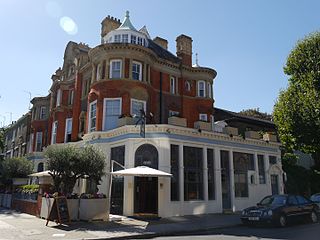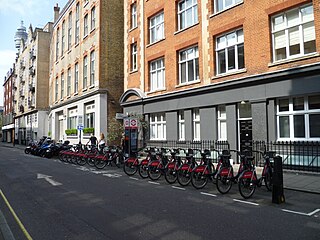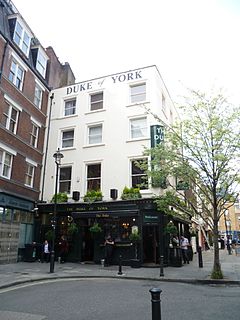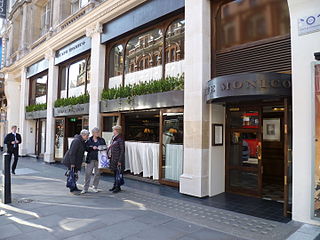
A pub, or public house, is an establishment licensed to serve alcoholic drinks for consumption on the premises. The term public house first appeared in the late 17th century, and was used to differentiate private houses from those which were, quite literally, open to the public as 'alehouses', 'taverns' and 'inns'. By Georgian times it had become common parlance, although taverns, as a distinct establishment, had largely ceased to exist by the beginning of the 19th century. Today, pubs have no strict definition, but CAMRA states a pub has four characteristics:
- is open to the public without membership or residency
- serves draught beer or cider without requiring food be consumed
- has at least one indoor area not laid out for meals
- allows drinks to be bought at a bar

The Wenlock Arms is a public house in Hoxton, in London's East End, which began trading in 1787. The pub is located halfway between Old Street and Angel, just off the City Road and the City Road Basin and Wenlock Basin on the Regent's Canal. The pub has won awards for the quality and range of its cask ales.

Timothy Taylor's is a family-owned regional brewery founded in 1858 by Timothy Taylor. Originally based in Cook Lane, Keighley, West Yorkshire, England. Timothy Taylor's moved to larger premises in 1863 at Knowle Spring in Keighley, where they remain.

The Coach and Horses at 29 Greek Street on the corner with Romilly Street in Soho, London, is a grade II listed public house.

The Punch Bowl, at 41 Farm Street, Mayfair, is a London public house, dating from circa 1750. It is listed as Grade II by English Heritage. It is a Georgian building and, although altered over the years, retains many period features including a dog-leg staircase, internal cornicing and dado panelling.
Truman's Brewery was a large East London brewery and one of the largest brewers in the world at the end of the 19th century. Founded around 1666, the Black Eagle Brewery was established on a plot of land next to what is now Brick Lane in London, E1. It grew steadily until the 18th century when, under the management of Benjamin Truman, and driven by the demand for porter, it expanded rapidly and became one of the largest brewers in London. Its growth continued into and through the 19th century with the expansion of its brewery and pub estate. In 1873, it purchased Philips Brewery in Burton and became the largest brewery in the world.

Gordon Ramsay at Claridge's was a restaurant owned by Gordon Ramsay and located with Claridge's hotel in Mayfair, London. Blackstone Group had enquired about Ramsay's availability to open a restaurant after he was awarded three Michelin Stars at Restaurant Gordon Ramsay. It marked the first of a number of restaurants that Ramsay would open at hotels owned by Blackstone. It opened in 2001, and by the fourth year was making a profit of £2 million a year. Mark Sargeant was the chef de cuisine of the restaurant until 2008, during which time the restaurant was awarded a Michelin star.

Crocker's Folly is a Grade II* listed public house at 24 Aberdeen Place, St John's Wood, London. It was built in 1898, in a Northern Renaissance style, and was previously called The Crown. Geoff Brandwood and Jane Jephcote's guide to heritage pubs in London describes it as "a truly magnificent pub-cum-hotel" with "superb fittings", including extensive use of marble. The architect was Charles Worley.

The Swan & Edgar was a public house at 43 Linhope Street, Marylebone, owned by Bourne and Hollingsworth Group, notable for its claim to be the smallest pub in London.

The Square and Compass is a Grade II listed public house in Worth Matravers, Dorset. Built in the 18th century as a pair of cottages before becoming a public house, the Square and Compass got its name in 1830 from a landlord who had been a stonemason. The building includes a museum of fossils and other local artefacts and the pub is one of only nine nationally that has been included in every edition of CAMRA's Good Beer Guide.

The Five Mile House is a former public house on Old Gloucester Road, Duntisbourne Abbots, Gloucestershire, England. It was built in the 17th century and is grade II listed.

Rathbone Street is a street in London that runs between Charlotte Street in the north and the junction of Rathbone Place and Percy Street in the south. The street is partly in the London Borough of Camden and partly in the City of Westminster.

The Duke of York is a public house at 47 Rathbone Street, Fitzrovia, London, W1. It is located in the north of the street on the corner with Charlotte Place and bears the year 1791.

The Carlton Tavern was a pub in Kilburn, London that was demolished under controversial circumstances and which the developer has since been ordered to rebuild. The pub was the only building in the street to survive the Blitz during World War II.

Drunch is a gastropub at 38 St John's Wood Terrace, St John's Wood, in the City of Westminster, London. It was a pub for 200 years before closing in March 2015. The following month Westminster City Council listed it as an asset of community value in order to prevent the property being converted to flats, but this did not prevent the pub being used as a bogus estate agent office. This left only three pubs remaining in the St John's Wood High Street area of John's Wood, with 13 estate agents established. In 2017 it reopened as a restaurant and bar.

Café Monico is a restaurant on London's Shaftesbury Avenue.

The Polish Hearth Club is a private members club founded soon after the outbreak of World War II by the British Government and the Polish government-in-exile at 55 Princes Gate, Exhibition Road in the City of Westminster, London, close to the South Kensington museums, in a Grade II listed building.It was intended as social meeting place for diplomats, the military cadre and other officials. The facilities included a restaurant,, a theatre and an exhibition space. It faces the main entrance to Imperial College London and is around the corner from the Polish Institute and Sikorski Museum, which was built as part of one development by Charles James Freake.


















